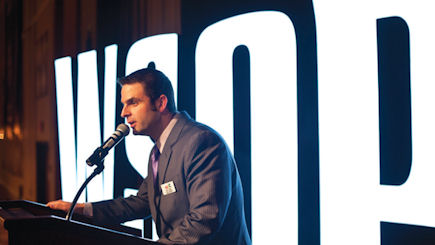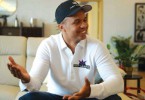This article first appeared in the Nov/Dec 2015 issue of WGM.
Images: WSOP/Giron Photography
Since joining the World Series of Poker in 2005 – the same year it moved to the Rio after 35 years at Binion’s Horseshoe Casino – Jack Effel has established himself among poker’s elite tournament directors and is the main man in charge of the world’s biggest and most prestigious tournament – the WSOP Main Event. He also has the daunting task of overseeing a 1,500-strong team of staff across the two months the WSOP runs each year, his responsibilities including staffing, event structuring, payout calculations and all tournament operations. With the 2015 November Nine just around the corner, Effel sat down with WGM Managing Editor Ben Blaschke to discuss his career and all things poker.

Ben Blaschke: It’s great to chat to you Jack. You’ve been working with the WSOP since it first moved from Binion’s to the Rio in 2005, but before we get to any of that can you tell us a bit about how your poker journey began?
Jack Effel: Sure. This is my 19th year in poker. I started when I was 21 as a dealer in Mississippi. I grew up in Dallas, Texas and had aspirations as a teenager in the 90s to move to California one day. You know, “Go west young man” and become a poker dealer and a card player. I went out to California when I first turned 21 and was offered a job.
When I was a teenager I was around pool halls and I dealt some private card games and blackjack on New Year’s Eve – stuff like that. I wanted to work in a casino and play poker. Now, I didn’t know this at the time but my father actually ran poker games back in the army in World War II! He was 27 years older than my mother and 63 when I was born. My mother’s father also used to run a poker game on Friday nights.
So I ended up in the casino business while I was going to college and working on my degree, then towards the tail end of all of that the poker boom happened which led to an opportunity for me to travel the world through the poker circuit. In 2005 I came to Las Vegas to assist with the WSOP for the first time and was then given a higher position by Harrah’s which has built into the position I hold today.
These days I’m the WSOP guy when it comes to all things poker operations offline. It’s been a great journey. In 2005 I came in as an assistant, the second year I came in as co-director and since 2007 I’ve been on my own in terms of the tournament director role. But since that time my role has also expanded to handle more things outside Las Vegas whether it be the circuit events, international expansion, setting up poker rooms, selling sponsorship or whatever it might be. It’s been fantastic.

BB: Looking back to the poker boom you mentioned, it obviously all started in 2003 when Chris Moneymaker won the WSOP Main Event and then Joe Hachem’s win in 2005 had a similar impact in Australia which saw the game gradually spread across Asia. Your timing couldn’t have been any better!
JE: It was an interesting time, right? I came along at a time when a lot of the guys in poker were the old time poker guys and although they were knowledgeable and great in their own right, it was just a different time. Everything was much smaller. It was a smaller community, the hospitality side of things was different – everyone could get a buffet. This was coming off of Binion’s closing and the WSOP moving to the Rio. The ownership of the WSOP moved to Harrah’s so there was the whole corporate side of things for running poker.
At the same time online poker and poker on television were coming through so they were looking for people that could speak the language but also understood the business. I had the benefit of knowing how to deal with the poker players but I also went to business school. Being able to work with the players, understand the operations, the maths behind all of the events, the structure and payouts, the logistics of moving all the bodies in and out, the registration program – I’ve been an integral part of the development of all of those processes over the years.
A lot of the stuff we do here when you look back to those early days, I created a lot of it. I made all the early errors when we were running those first big tournaments but I also came up with the solutions on how to run them better. There were a lot of things people didn’t know because no one ran multi-thousand people fields. Now we can run a 22,000 player field [the new Colossus event at this year’s WSOP attracted a record live field of 22,374 players – Ed] like it was a 200 player field because the processes work. The things that change are the dynamics that surround the tournament such as the processing of the payouts and decreasing wait times. Now that we’ve figured out how to run these tournaments, our main thing is how to make the experience better.
Every year we take feedback, we talk to players, we brainstorm and we think of new events that can enhance the schedule. Some things we get right and some things we don’t. This year I think we got a lot of things right and a couple of things wrong but the things we got wrong weren’t oversights, they were just things nobody thought of. That’s where you learn and you grow. The challenge is trying to oversee the improvements we make through everyone that’s working for you. I have 1,400 or 1,500 employees between all the different areas and they all roll up to me one way or the other. Some things you can’t predict like computers going down on the night of Colossus for four hours when you’ve got 700 people waiting to get paid out of the 2,200 you were paying. Or deciding to hold such a big event and have everyone pre-register – we didn’t know we were going to get 12,000 pre-registrations! Things like that come up and you go, “Wow.”
![[b]Jack Effel began working at the WSOP in 2005, the year Australia's Joe Hachem won the Main Event[/b]](http://www.wgm8.com/wp-content/uploads/2015/10/images_wgm_1038_the-house-that-jack-built-3.jpg)
BB: The WSOP has made a habit of introducing new and innovative tournaments like the Colossus each year. How do you come up with these new concepts?
JE: A few years ago we decided we’d create an event, theme it like an anchor and build something around it. When we first started tinkering with anchors they were just basic No Limit Hold’em events held each weekend throughout the WSOP and we figured those would draw the masses. People would come out for the weekend, some would play two weekends and that was about it, but then we realized there were so many similar events available all over the place that people would just pick and choose when they would come. They’d think, “Well, if there is always a No Limit Hold’em event every weekend I’ll just pick the weekend that suits me best and play that one.”
So we then started thinking about how to differentiate events to make people want to play more weekends – to give the players a bit more variety. That’s when we started coming up with things like the Millionaire Maker and the Monster Stack and now the Colossus. One thing we’ve determined through feedback is that players want the events to have a meaning or a definition – to be defined as something. So the Millionaire Maker had a guaranteed US$1 million for first place, the Colossus had the biggest live tournament field ever, the Monster Stack had a 10-times starting stack which is unheard of.
The other thing unique about the WSOP is that it’s the only place where you can really play all the disciplines of poker because they’re not played anywhere else. Some disciplines aren’t played a great deal as a percentage but this is the place you can come to play them because we keep them alive. This is poker paradise and we want to keep it that way. You can come here and play whatever you want but also have a shot at really making it big. You can win a bracelet, win a lot of money, get on television and become a household name. Your dreams can come true here at the WSOP and I’m not sure anyone else offers anything remotely close to that. You might go and win US$1 million in another poker tournament but is it the same as winning a WSOP bracelet and what comes with it? I don’t think it’s even close.
BB: Obviously when running an event of this size, problems will arise from time to time and there was a fairly sizeable one this year in regards to the new Modiano cards being used for the first time. A number of players complained that the cards were too thin and were easily marked. What went wrong?
JE: Well, Modiano has been a card manufacturer for over 100 years. They’ve been around since 1868 and have been used all over Italy. They are highly respected on every single level. We looked at them because we had a connection through our personnel and they were very gracious and generous with the opportunity to partner with them. It was a big deal for them to be able to provide their product to the WSOP, be recognized by the players and enter into new markets just like any other business would want to. But we play a lot of games that nobody plays and have a lot of players that play differently than normal. When you play in Italy you play two-card Hold’em, you look at your cards once or in a lot of cases guys just pick the two cards up and look at them in their hand. They’re not pinching them and they’re not digging into them, so from their perspective they’re thinking, “These cards are great. They’re used all over the country and we’ve never had a problem.”

Then when they got into this environment I think they realized they needed higher quality, more durable cards because the players at the WSOP are more aggressive with them. They don’t stand up as well in this environment. But Modiano stepped up to the plate. They sent us newer cards that are higher quality and we’ve had zero complaints. A lot of players have even said they like them better than the Kem cards. So I think the whole deal was trying to find the right card that would be good for the WSOP and even if they didn’t get it right the first time, they got it right the second time.
Any time you’re partnering with anyone, you want them to be someone who can take criticism, look at the product and make it better. That’s the same business that we’re in. Then again, poker players are hyper critical and when something goes wrong they will let you know about it. Something as important as the cards can make a lot of other things start to seem bad too. Cards are important because you’re playing for money which is emotional and if players feel they’re not getting a fair shake, that’s a problem.
BB: I recall another interesting problem a few years ago where some of the chip denominations were difficult to tell apart.
JE: Yes it was the 5k, the 25k and the 50k chips. Chips are really interesting actually. I have almost 900,000 individual chips here at the WSOP, so we’re pushing the million mark in terms of all the different chips through all the different sets. And every time you create a chip, it needs to look different to the same denomination chip in a different set – or even another denomination chip in a different set. So think about how many denominations of chips you have in one set and multiply that by six or seven … you start coming up with all sorts of funky combinations!
When you’re looking at the samples and you start putting all the chips side by side to see what looks good with the other chips, you need to make sure none of them look too similar but if you produce enough chips over time then eventually you’re going to make a mistake. Sometimes the artwork you get for a chip also looks very different from the final product. You have to be careful with certain colors like orange and pink and red because they’re very close.
BB: As a board member of the Poker Tournament Directors Association, you have a big say in overseeing the official rules of the game and there was a notable change at the recent Poker TDA Summit in regards to when a player must be seated. Two years ago, the “first card off the deck” rule was introduced which stipulated a player’s hand would be killed if they weren’t in their seat when the first card was dealt. That rule has now been quashed and we’ve returned to the former “last card off the deck” rule instead. What are your thoughts on the two?
JE: I wish I was as passionate about it as everyone else is outside of the fact that I know from a players’ standpoint the last card seems to make more sense in this environment, just because I’ve got guys bouncing around from table to table, I’ve got guys outside signing autographs or making deals with each other. And they sit in their seat for up to 15 or 16 hours a day, so to tell them they have to stay in their chair is very difficult. I understand why “first card off the deck” is better for the operator but it’s not better for all of the players. I look at first card off/last card off as how we view rules collectively. Everyone approaches rule making for poker differently.

From my standpoint, yes there are rules that people must abide by to play but I don’t like to create rules that basically tell you how to play. I prefer to create rules around the way people naturally play. You want an environment where players are comfortable, they can play cards and their game is protected. Penalties and rules are there to protect the game but rules should be to govern it in its natural state and not make people conform to this very stringent, tight style of play where they’re all robots. I try to make the game fun and comfortable while maintaining its integrity.
BB: What are your thoughts on players speaking to one another in different languages while at the table?
JE: I’m not going to say that I’m completely open to letting anyone speak any language they want so I have certain rules. I don’t like anybody talking across the table in a different language while a hand is in play. I don’t like them seeking advice from an outside source while in the hand. If you want to talk to somebody on the rail, do it out of the hand and away from the table. I don’t care what you want to talk about, just do it away from the table. I think that if you’re at a place where French is the universal language you should be able to speak in English and French. If you’ve got Chinese and Vietnamese and Thai then those languages should be prominent along with English. It should be the native tongue and English, which is pretty universal around the world. By the way, I think for the most part the players are going to police themselves. I’d be more concerned if there were only two French people as opposed to, say, five French and five Americans because they can’t all be dishonest!
BB: We’ve recently seen online poker return to three American states – Nevada, Delaware and New Jersey – although for now online gaming remains banned across the rest of the country. Of course, the WSOP is one of a handful of players in this new online poker market through WSOP.com. What do you think the future holds for online poker in the USA?
JE: I can’t really answer that, but what I can say is online poker is a great tool for learning the game as well as being a great thing for anyone that already loves the game. Online poker is basically an online tutorial to create new players who will eventually, hopefully, come and visit us here at the WSOP. It’s another way for them to get from one point to another. How do you get to Carnegie Hall? You practice, practice, practice. This allows players to develop their skills and the technical aspects of their game, to learn the mathematics, to build their bankrolls and do all those kind of things. The negatives people hear about online poker are far outweighed by the benefits. And it is critical to the future of the game. The fact of the matter when you look at poker is that not everyone is a winner. The same applies to regular sports – there is a winner and a loser – and the same with the stock market. Poker is no different. But online poker is crucial to the growth and evolution of the game.
BB: Liquidity will obviously remain a problem for America’s online poker sites for as long as the majority of the country is locked out. What are your thoughts on player numbers at WSOP.com so far?
JE: This year we had an online bracelet event for the first time and it attracted 905 players which is fantastic. The liquidity is not terrible considering the players are all here in the state. I haven’t been keeping up too much with what’s been going on this summer but I know there has been a lot of activity and a lot more guys playing this year than last year. They’re obviously enjoying the game. Anybody that loves poker should be a supporter of online poker. We saw what it did in the early days to develop new players and teach them how to play. Now it’s even more important to continue to find ways to do that. We just hope that one day it is wide open and regulated so people can play freely in their robes or offices and continue to participate. That’s the other thing – a lot of people want to play poker but can’t because they don’t have access to it! If you live somewhere that doesn’t have live casinos and you don’t want to play in a private game where you might risk being robbed or killed, having the ability to play online is great.
BB: Back to the land-based version of the game and there have been rumors swirling for years that the WSOP could be moved to Caesar’s Palace for one reason or another. Can you see it happening?
JE: No. I think the Rio is a great place for the WSOP. As much as we have other places where it could also be held, this is a great place to have it. There is plenty of parking, the hotel is great, it’s big and it’s set up for this event. We know how it works, the stakeholders love having it here and they embrace it. The problem with holding the WSOP elsewhere is that first, you’d have to find a place that was big enough, then you’d have to find someone that loves it as much as we do which is really hard. I think the Rio is a pretty damn good place to host it. They’ve been absolutely gracious in hosting the WSOP these past 10 years and they’ve worked very hard to improve. They listen to the players and let’s face it – for two months every year this is the place to be. Caesar’s Palace might be the flagship property for Caesar’s Entertainment but the Rio in June and July … there is no place like it. It’s not even close. This is like Woodstock, the place everybody wants to be.
BB: On a lighter note, what are some of the funnier things you’ve seen at the WSOP over the past 10 years?
JE: One of the funniest things I’ve ever seen was the first year I was working here when Johnny Chan and Phil Laak were heads-up for a bracelet in a US$2,500 PLO event. Phil was relatively new to the WSOP at the time but he’s a crazy personality and that heads-up clash was one of the funniest things I’ve ever seen. He was yelling “It’s Johnny f****** Chan, it’s Johnny f****** Chan!” and doing push-ups and sit-ups between hands, shadow boxing. Johnny could barely play! He ended up winning his 10th bracelet but it was hilarious to watch. There have been some funny moments in this building over the past 10 years. I’ve seen players take bad beats and fall over crying, I’ve seen people go nuts running through the building when they’ve won a big hand. I’ve even seen a panda fall out of the audience! That was great during the final table of the 2013 WSOP Main Event – a guy in a panda costume comes flying out of the stands, trips over the stage and hits the deck. In a million years I could never have expected that to happen! There was the time Phil Hellmuth crashed a race car in the parking lot … we’ve seen some unusual and interesting things.
BB: One of the biggest changes to the WSOP Main Event came in 2008 when the concept of the November Nine was first introduced, which saw the tournament halted for three months once the final table was set with the remaining players returning in November to play to a winner. You must be pleased by its success, even though it was quite controversial when first announced?
JE: I am. I remember when we were told, I was sitting there with this look on my face trying to understand the potential ramifications of what could happen. Everyone was talking about the prospect of someone dying in the meantime, but at the end of the day if someone didn’t make it back for something like that, their chips would blind off and the money would go to the estate or next of kin.
The November Nine really allows people to get to know the players and get excited about what’s going to happen. To me, I think it’s the greatest thing we’ve ever done with the Main Event. I give Ty Stewart (WSOP Executive Director) credit for that – it was his big idea for the November Nine and it’s been amazing. I mean, everyone knows who they are. You remember the November Niners and it’s a bit like watching your favorite show – you follow them on their journey to the bracelet.

BB: The incredible growth of the WSOP has also seen the number of events and therefore bracelets on offer grow along with it to the point where there were 68 bracelet events in 2015 with another 10 on offer at the upcoming WSOP-Europe in Germany in October. Is there a danger that having so many bracelets could potentially devalue them?
JE: I don’t think so at all. With the sheer volume of people playing now – this year we went over 100,000 entries for all the bracelet events for the first time and are bringing more people in all the time. If you think about it, 68 bracelets out of 100,000 people is nothing. A lot of people are going to win some money, maybe 15,000 of them, but that means 85,000 are going to lose. I think that makes a bracelet pretty prestigious. It’s an amazing feat to win one and even more amazing that Phil Hellmuth has won his 14th. And even with 68 bracelets, the Main Event bracelet stands above the rest as the jewel in the crown. I’ve been to tournaments all around the world and have witnessed some incredible moments but there is nothing like the WSOP Main Event. It’s different to the others. Even at the WSOP, we’ve got a few special events on the schedule each year like the US$50,000 Poker Players’ Championship but none of them compare to the Main Event. There is something in the air when you walk in on the first day of the Main Event. The atmosphere is electric. And it doesn’t matter whether you’re a professional playing for the 10th time or just some guy who has saved up for months so he can experience it once in his life, the WSOP Main Event is the one tournament every poker player in the world dreams of winning. As far as I’m concerned, it will always be poker’s pinnacle.







